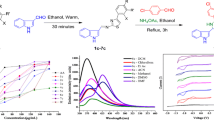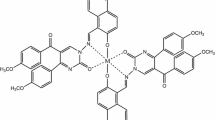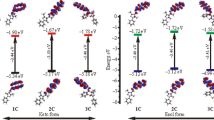Abstract
A series of Schiff bases (L 1 , L 2 and L 3 ) were prepared by refluxing aromatic aldehydes with N-Aminopyrimidine derivatives in methanol and ethanol. The structures of synthesized compounds were characterized by FTIR, 1H NMR, 13C NMR and microanalysis. The electrochemical behaviors of the Schiff base ligands were also discussed. Moreover, the evaluation of absorption and emission properties of the structures were carried out in five different solvents. The products show visible absorption maxima in the range of 304–576 nm, and emission maxima from 636 to 736 nm in all solvents tested.







Similar content being viewed by others
References
Taha ZA, Ajlouni AM, Al-Hassan KA, Hijazi AK, Faig AB (2011) Syntheses, characterization, biological activity and fluorescence properties of bis-(salicylaldehyde)-1,3-propylenediimine Schiff base ligand and its lanthanide complexes. Spectrochim Acta A 81:317–323
Zhou L, Cai P, Feng Y, Cheng J, Xiang H, Liu J (2012) Synthesis and photophysical properties of water-soluble sulfonato-Salen-type Schiff bases and their applications of fluorescence sensors for Cu2+ in water and living cells. Anal Chim Acta 735:96–106
Guo D, Wu P, Tan H, Xia L, Zhou W (2011) Synthesis and luminescence properties of novel 4-(N-carbazole methyl) benzoyl hydrazone Schiff bases. J Lumin 131:1272–1276
Majumder A, Rosair GM, Mallick A, Chattopadhyay N, Mitra S (2006) Synthesis, structures and fluorescence of nickel, zinc and cadmium complexes with the N, N, O-tridentate Schiff base N-2-pyridylmethylidene-2-hydroxy-phenylamine. Polyhedron 25:1753–1762
Basak S, Sen S, Marschner C, Baumgartner J, Batten SR, Turner DR, Mitra S (2008) Synthesis, crystal structures and fluorescence properties of two new di- and polynuclear Cd(II) complexes with N2O donor set of a tridentate Schiff-base ligand. Polyhedron 27:1193–1200
Cleiton M, Da S, Daniel L, da S, Luzia V, Modolo RBA, Maria A, de R, Cleide VB, Martins A d F (2011) Schiff bases: a short review of their antimicrobial activities. J Adv Res 2:1–8
Khuhawar MY, Mughal MA, Channar AH (2004) Synthesis and characterization of some new Schiff base polymers. Eur Polymer J 40:805–809
Pandeya SN, Srirama D, Nathb G, DeClercq E (1999) Synthesis, antibacterial, antifungal and anti-HIV activities of Schiff and Mannich bases derived from isatin derivatives and N-[4-(4′-chlorophenyl)thiazol-2-yl] thiosemicarbazide. Eur J Pharma Sci 9:25–31
Muratov N, Mescheriakov AK (2005) Investigation of anticancer activity of macrocyclic Schiff bases by means of 4D-QSAR based on simplex representation of molecular structure. SAR QSAR Environ Res 16:219–230
Casellato U, Vigato PA (1977) Transition metal complexes with binucleating ligands. Coord Chem Rev 23:31–50
Kandil SS, Katib SMA, Yarkandi NHM (2007) Nickel(II), Palladium(II) and Platinum(II) Complexes of N′-Allyl-N′-pyrimidin-2-ylthiourea. Trans Met Chem 32:791–798
Fahmy HTY, Sherif Rostom SAF, Bekhit AA (2002) Synthesis and antitumor evaluation of new polysubstituted thiazole and derived thiazolo[4,5-d] pyrimidine systems. Arch Pharm Pharm Med Chem 5:213–222
Nasr MN, Gineinah MM (2002) Pyrido[2,3-d]pyrimidines and pyrimido[50,40:5,6]pyrido [2,3-d]pyrimidines as new antiviral agents: Synthesis and biological activity. Arch Pharm 335:289–295
Tozkoparan B, Ertan M, Kelicen P, Demirdamar R (1999) Synthesis and anti-inflammatory activities of some thiazolo[3,2-a]pyrimidine derivatives. Il Farmaco 54:588–593
Amr EA, Ashraf MM, Salwa FM, Nagla AA, Hammam AG (2006) Anticancer activities of some newly synthesized pyridine, pyrane, and pyrimidine derivatives. Bioorg Med Chem 14:5481–5488
Kumar N, Singh G, Yadav AK (2001) Synthesis of some new pyrido_2,3-d_pyrimidines and their ribofuranosides as possible antimicrobial agents. Heteroat Chem 12:52–56
Mangalagiu G, Ungureanu M, Grosu G, Mangalagiu I, Petrovanu M (2001) New pyrrolo-pyrimidine derivatives with antifungal or antibacterial properties. Ann Pharm Fr 59:139–140
Viciano-Chumillas M, Tanase S, Aromí G, Smits JMM, de Gelder R, Solans X, Bouwman E, Reedijk J (2007) Coordination Versatility of 5(3)-(2-Hydroxyphenyl)-3(5)-methylpyrazole: Synthesis, Crystal Structure and Properties of CoIII, NiII and CuII Complexes. Eur J Inorg Chem 18:2635–2640
Roy S, Mandal TN, Barik AK, Pal S, Gupta S, Hazra A, Butcher RJ, Hunter AD, Zeller M, Kar SK (2007) Metal complexes of pyrimidine derived ligands—Syntheses, characterization and X-ray crystal structures of Ni(II), Co(III) and Fe(III) complexes of Schiff base ligands derived from S-methyl/S-benzyl dithiocarbazate and 2-S-methylmercapto-6-methylpyrimidine-4 carbaldehyde. Polyhedron 26:2603–2611
Salih NA (2008) Synthesis and characterization of novel azole heterocycles based on 2,5-disubstituted thiadiazole. Turk J Chem 32:229–235
Roy S, Westmaas JA, Buda F, Reedijk J (2009) Platinum(II) compounds with chelating ligands based on pyridine and pyrimidine: DNA and protein binding studies. J Inorg Biochem 103:1288–1297
Nakamoto K (1997) Infrared spectra and Raman spectra of inorganic and coordination compounds. John Wiley & Sons, New York
Tümer M, Deligönül N, Gölcü A, Akgün E, Dolaz M, Demirelli H, Dığrak M (2006) Mixed-ligand copper(II) complexes: investigation of their spectroscopic, catalysis, antimicrobial and potentiometric properties. Trans Met Chem 31:1–12
Sönmez M, Çelebi M, Berber İ (2010) Synthesis, spectroscopic and biological studies on the new symmetric Schiff base derived from 2,6-diformyl-4-methylphenol with N-aminopyrimidine. Eur J Med Chem 45:1935–1940
Huang G, Song Q, Ma Y (2001) Metal complexes of ferrocenecarboxaldehyde 2,4 dichlorobenzoylhydrazone. Synth React Inorg Met Org Chem 31:297–302
Pal SK, Krishnan A, Das PK, Samuelson AG (2000) Schiff base linked ferrocenyl complexes for second-order nonlinear optics. J Organomet Chem 604:248–259
Kılıç H, Berkem M (2004) Electrochemical behavior of some new pyrimidine derivatives. J Serb Chem Soc 69:689–703
Akbas E, Levent A, Gümüş S, Sümer MR, Akyazı İ (2010) Synthesis of some novel pyrimidine derivatives and investigation of their electrochemical behavior. Bull Korean Chem Soc 31:3632–3638
Sönmez M, Çelebi M, Levent A, Berber İ, Şentürk Z (2010) Synthesis, characterization, cyclic voltammetry, and antimicrobial properties of N-(5-benzoyl 2-oxo-4-phenyl-2H-pyrimidine-1-yl)-malonamic acid and its metal complexes. J Coord Chem 63:1986–2001
Sönmez M, Çelebi M, Levent A, Berber İ, Şentürk Z (2010) A new pyrimidine-derived ligand, N-pyrimidine oxalamic acid, and its Cu(II), Co(II), Mn(II), Ni(II), Zn(II), Cd(II), and Pd(II) complexes: synthesis, characterization, electrochemical properties, and biological activity. J Coord Chem 63:848–860
Cai T, Xian M, Wang PG (2002) Electrochemical and peroxidase oxidation study of N′-Hydroxyguanidine derivatives as NO donors. Bioorg Med Chem Lett 12:1507–1510
Akçamur Y, Altural B, Sarıpınar E, Kollenz G, Kappe O, Peters K, Peters E, Schering HJ (1988) A convenient synthesis of functionalized 1H-pyrimidine-2-thiones. Heterocycl Chem 25:1419–1422
Gagne RR, Spiro CL, Smith TJ, Hamann CA, Thies WR (1981) Shiemke; A.K. The synthesis, redox properties, and ligand binding of heterobinuclear transition-metal macrocyclic ligand complexes. Measurement of an apparent delocalization energy in a mixed-valent copper(I)copper(II) complex. J Am Chem Soc 103:4073–4081
Gülcan M., İspir E, Sönmez M (2012) International Symposium on Metal Complexes, vol. 2. Lisbon, Portugal.
Gülcan M, Çelebi M, Sönmez M (2012) International Symposium on Metal Complexes, vol. 2. Lisbon, Portugal.
Acknowledgments
The authors wish to thank Presidency of Scientific Research Projects of University of Yuzuncu Yil (2011-FED-B009) for the financial support.
Author information
Authors and Affiliations
Corresponding authors
Rights and permissions
About this article
Cite this article
Gulcan, M., Doğru, Ü., Öztürk, G. et al. Fluorescence Properties and Electrochemical Behavior of Some Schiff Bases Derived from N-Aminopyrimidine. J Fluoresc 24, 389–396 (2014). https://doi.org/10.1007/s10895-013-1303-x
Received:
Accepted:
Published:
Issue Date:
DOI: https://doi.org/10.1007/s10895-013-1303-x




